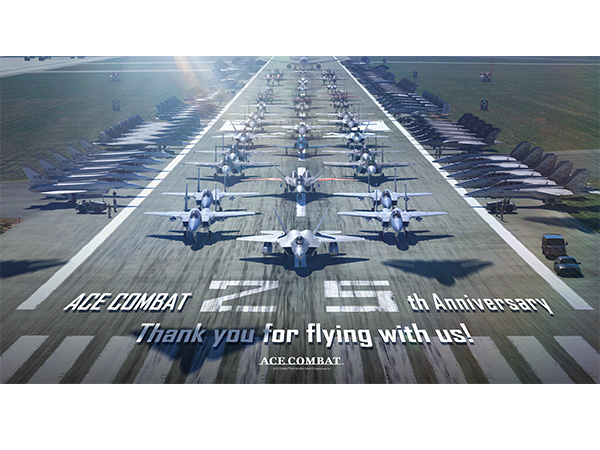25 years after the launch of the series, Ace Combat continues to stand at the top of the flight combat genre. In the second half of our interview, we spoke with brand director Kazutoki Kono and Ace Combat 7: Skies Unknown producer Manabu Shimomoto about the production process to find out the secrets behind its popularity!
*This article was originally released in Japan on July 28, 2020.
You can read about the history of the series in the article: Ace Combat 25th Anniversary Project [Part 1] – Looking at 25 Years of Ace Combat History with Two Key Team Members
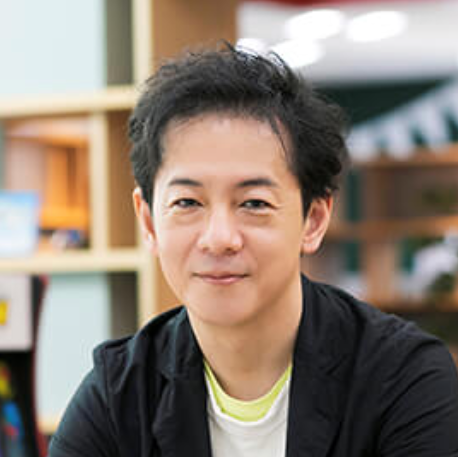
Kazutoki Kono
Ace Combat Series Brand Director
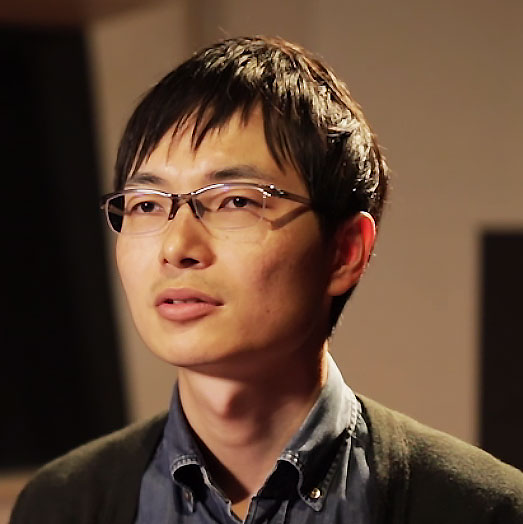
Manabu Shimomoto
Producer for Ace Combat 7: Skies Unknown
All of the Excitement, None of the Hassle! How the Concept Behind the Ace Combat Series Came to Be
It’s been said that the concept behind the Ace Combat series has been this idea of offering players the chance to feel like ace pilots themselves. How did this concept come about?
Kono: That concept is one that hasn’t changed since the very start of the series. We hadn’t yet put this concept into words back then though. I think it came to be through a combination of our TV ads, player reactions, and the ambitions of the original development team.
From its start, the series was not a flight simulator but a flight combat game. The focus was not on realism but letting players feel like fighter pilots. This is sort of our grounding point and when our games start to feel like they’ve gone beyond the scope of the combat experience and start to feel more like simulators, we often talk among ourselves about how that’s not the sort of game we should be making.
The TV ads for ACE2 played off this, featuring a certain well-known CEO sitting in his office, enjoying the game as if he was a kid again, describing it as an all-out piloting experience.
Kono: That commercial was made by Sony (manufacturer and retailer of PlayStation®), but they really did a great job of showing the key draw of the series. It’s one of my favorites. At its core, I think Ace Combat is really about “feeling” like a pilot. Feeling like you can fly a fighter jet.
Where do both of you think the enjoyment lies in this “feeling?”
Kono: I originally started working for NAMCO and back then, the company’s games all shared four major elements of play: mimicry, competition, chance, or altered-perception (from Roger Caillois’ “Man, Play and Games”). Ace Combat made use of these elements with the altered-perception of flying through the skies, the excitement of competition, and the joy found in mimicking a fighter pilot. NAMCO valued this philosophy in game development for series like Ridge Racer and TEKKEN.
Shimomoto: We focus on extracting the best parts of aerial combat. For instance, rather than using long-range missiles to take down enemies, we focus on flying through the skies, avoiding incoming fire from enemy aircraft, and shooting down targets right in front of the player’s eyes. We try not to let ourselves veer too far away from that sort of fun and excitement.
Kono: We share these ideals because we’ve experienced the failure of doing otherwise. We’ve made mistakes over these past 25 years and have taken the time to reflect on who exactly we are making games for, and what it is that makes them happy. We all feel a similar way because we’ve been through this all together.
How Do You Design What Players Feel? In Ace Combat the Emotional Payout Comes from Elaborate Planning
I’d like to hear from you both about the Ace Combat production team’s process and techniques. I’ve heard you use a concept sheet now that lays out the foundation concepts for your titles. Can you tell us more about what exactly this sheet is?
Kono: The format for this concept sheet is one we only settled on recently, but the contents within it come from discussions we had after the launch of Assault Horizon, which we talked about in the first part of the interview. This sheet was designed as a logical way to outline the development policy we settled on.
Shimomoto: After experiencing the failure of Assault Horizon, we began putting down in writing what Ace Combat should be and this was eventually formalized to take the form of this concept design sheet. This has actually been introduced throughout the rest of BANDAI NAMCO Entertainment for use on other titles now as well. It was Kono-san who put together the basis for this sheet.
I see! So, a new initiative that started with the Ace Combat series has now become a company-wide policy. I also heard that for Ace Combat, you create and share graphs that chart the shifts in player emotion.
Kono: That’s our “Player Emotional Blueprint.” It’s essentially a line graph that tracks how player emotions will change as they play through missions. We use these to help us think through how players will experience the joys and sorrows of playing the role of hero, through a story that feels like a true life experience. It’s something that started with ACE5.
Originally it was meant to indicate what the intended emotion of each section should be for music production purposes but later on I found out that a similar process is used in Hollywood films as well. In the beginning though, no one really knew how to balance things. When we first introduced them, the graphs would hit max values by mission 3 and numbers had doubled by the time we reached mission 10. (laughs)
Now they turn into much more complicated graphs than they were back then. With ACE7, for instance, we had a number of factors including enemy emotions, enemy forces, ally emotions, ally forces, and player emotion plotted along the y axis and a timeline along the x axis, allowing us to plan game scenarios and intended emotional impact at the same time.
Shimomoto: Essentially, we first graphed out the emotions of every person that made an appearance in the game and then we fit that into the game itself.
That…sounds like quite the process!
Kono: It was torturous. (laughs)
Shimomoto: Yeah. Without a doubt. (laugh)
Kono: But still, thanks to all that, we were able to pick out where the story was lacking and what portions took longer than they should to play out. We ended up drastically switching up the order of the missions and it allowed us to keep emotions constantly in motion throughout the game. I’m a designer, originally, but back at university I did my graduation research on diagrams and I enjoy making graphs and illustrations of abstract things.
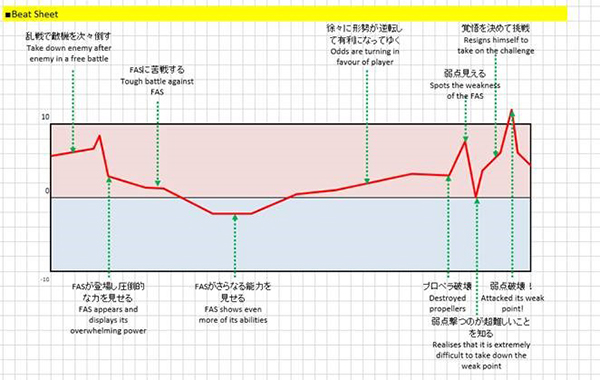
Are there any other signature characteristics of the Ace Combat production team?
Kono: Shimomoto-san and I tend to logically think about what it is our customers are expecting of us. But there are other people on the team like our art director Masato Kanno and narrative director Kosuke Itomi who have a more artistic, natural genius to the way they think, and they come up with things our customers would want; less through reasoning standpoint but more through an emotional standpoint.
When you try asking people like that for their reasoning, they just tell you, “Because it’s better this way.” (laughs) But unless it’s something that doesn’t fit within our original title concept or statement, our team trusts their ideas. Though they might not be able to put it to words, they have this real sense of what is best for our customers, and we’ve learned to have faith in them through all these years we’ve worked together.
I see. So, you put your trust in the senses of the team as you work through production. Do you have designated staff to handle licensing rights for the fighter aircraft that appear in the games?
Shimomoto: We do. We have a number of middle-office and back-office teams that support our productions, including the teams that contact the licensors that manufacture the actual aircraft we use.
Kono: With ACE7, I got to see just how many different departments were involved in helping us. It helped me realize once again that the reason our team is able to focus solely on our customers is because we have so much support behind the scenes. This is a real benefit not only for Ace Combat, but probably for all of BANDAI NAMCO Entertainment. Whenever someone from another division does something for me, I make sure to send them an email that I type out without using any predictive text, telling them “Thank you. I appreciate what you’ve done for us.”
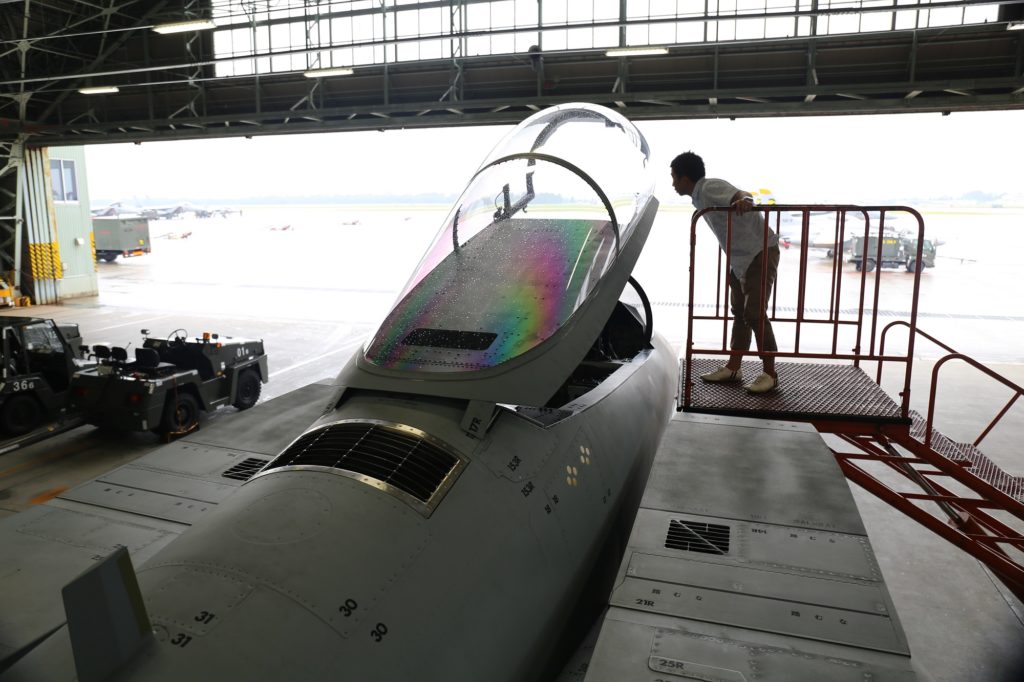
I see. A similar sort of sentiment to a handwritten letter, then.
Kono: Exactly. When I think back on the number of times I typed out my thank you notes to team members for their support on Ace Combat 7 in 2019, I really get a sense for the massive scale and the sheer number of people who supported us. It makes me realize that game titles are created thanks to such numerous exchanges of gratitude. I feel the same for our fans, as well.
Celebrating 25 Years with the Series – Fan Appreciation from the Production Team
I have the impression that both of you often express your appreciation directly to your fans. How does the production team feel about the fans of the games you all make?
Kono: I wish I could think of a more eloquent way to put this… Personally, I think of fans as comrades, but also much more than that. Fans of Ace Combat are sometimes strict critics too, and I am truly grateful for that. Our fans don’t just accept anything we give them. They support us and our work only after we provide them with moving experiences that offer joy and spark enthusiasm. They put their trust in us and await the new emotional experiences we create for them.
Shimomoto: It’s that trust that has made it harder and harder to meet all their demands as the expectations of our players continue to grow and diversify year after year. Our fans are no longer one homogeneous group of people, so we can no longer simply find one answer to please them all. It’s something I think we’re going to have to work at from here on out.
Kono: Of course, at the base of it all, our focus remains on providing players with a simple means of enjoyment and experiences that surpass expectations. I think that by experiencing the setbacks we’ve had, our team has grown to truly believe in this philosophy.
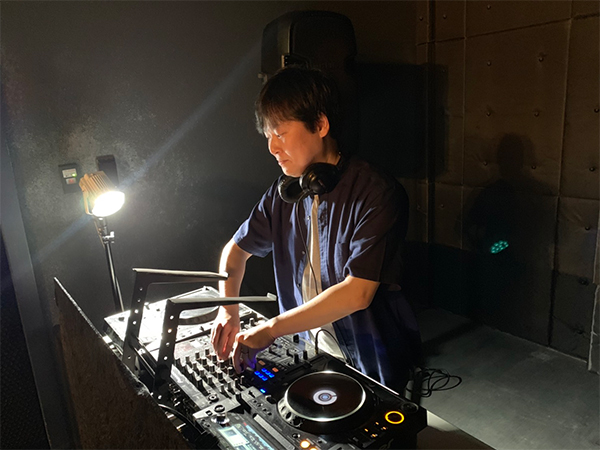
Sound Director Ryo Watanabe himself took stage to stir up the audience.
With the celebration of the series’ 25th anniversary, I’d like to ask you both now what excites you about the future of Ace Combat.
Kono: As Brand Director, I’d have to say I’m most excited about spreading the IP further around the globe. The ultimate goal for us is to provide our customers with joy and excitement through our games. Now that some time has passed since the launch of ACE7, we’re at the point where we are all starting to imagine what sort of things we can really hone in on next to provide just such experiences. Right after release, I feel we tend to be left in a sort of empty mental state that offers up no new ideas. But from there we start to take in all sorts of new input, until we reach a point where we start coming up with interesting concepts again.
Shimomoto: Speaking of spreading our IP further, we had ACE7 localized into 12 languages and sold over 2 million copies worldwide. But in order to enable even more people in more places experience the joy of Ace Combat, I want to see the series offer even more languages and be released in more regions around the globe. There are still so many more fighter aircraft in the world we haven’t included yet, so I’m hoping we can bring even more of them to the series.
Kono: We want to raise the bar for the excitement our players feel in ways like these. In order for BANDAI NAMCO Entertainment to continue competing at the highest level on a global scale, we need to offer high-end content, and I believe Ace Combat is a series that can do just that. I want to be a part of building Ace Combat into a globally renowned series and make it one that provides an even greater emotional experience for all who play it.
See the official Ace Combat 25th Anniversary page *JP
Ace Combat Official Information
[US] [EU]
Editor’s Note
Following up with the first part of our interview discussing the history of the Ace Combat series, this second part offered a look into the team ideology and thought processes that go into creating the exciting content it offers. What stood out most during the discussion was how both guests seemed to always talk with the end-goal of the customer experience in mind.
This interview served as a great reminder that the history of Ace Combat is built on the passion of the production team and the enthusiasm of its fans!
Jin Sugiyama
Freelance writer & editor. More fond of entertainment than just about anything.



